What Is a Total Solar Eclipse?
A total solar eclipse happens when the Moon completely covers the face of the Sun. To see it, you have to be somewhere within a narrow path of totality.

Next Total Solar Eclipse: 2026年8月12日水曜日 … See animation
Next Eclipse: Total Lunar Eclipse – 2025年3月14日金曜日 … See animation
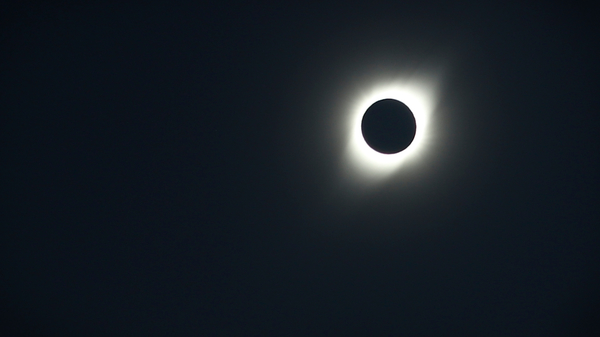
Totality: the length of time that the Moon completely covers the Sun can vary from a few seconds to over six minutes.
©Anne Buckle/timeanddate
Only Visible along a Narrow Path
Every 18 months or so—somewhere in the world—a total solar eclipse takes place.
The total phase of the eclipse, where the Moon completely covers the Sun, is visible from along a narrow path of totality. Typically, this path across the globe is around 15,000 km (9000 miles) long, but only about 150 km (90 miles) wide.
Which cities get the most eclipses?
Not Total Everywhere
Observers outside the path of totality may see a partial eclipse. By convention, eclipses are named after their darkest phase—if a solar eclipse is total at any point on Earth, it is called a total solar eclipse.
Hybrid solar eclipses or annular-total eclipses are an exception to this rule. This is because they change from an annular to a total eclipse or from a total to an annular eclipse along their path.
![]() Animation: Next eclipse in your city
Animation: Next eclipse in your city
Complete Solar Eclipse Has Five Phases
What can you see during a total solar eclipse?
There are five stages in a total solar eclipse:
- Partial eclipse begins (1st contact): The Moon becomes visible over the Sun's disk. It looks like the Moon has taken a bite out of the Sun.
- Total eclipse begins (2nd contact): The Moon covers the entire disk of the Sun, and observers are now within the Moon's umbra, the darkest part of the Moon's shadow. A diamond ring effect and Baily's beads are visible just before totality.
- Totality and maximum eclipse: The Moon completely covers the disk of the Sun. Only the Sun's corona is visible. This is the most dramatic stage of a total solar eclipse. At this time, the sky goes dark, temperatures can fall, and birds and animals often go quiet. The midpoint of time of totality is known as the maximum point of the eclipse.
- Total eclipse ends (3rd contact): The Moon starts moving away, and the Sun reappears. Those fortunate enough to be in the Moon's umbral can see Baily's beads and the diamond ring effect just after totality ends.
- Partial eclipse ends (4th contact): The eclipse ends as the Moon leaves the Sun's disk.
Protect Your Eyes!
Never look directly at the Sun, eclipsed or otherwise, without proper protective eyewear. The Sun’s radiation can burn your eye's retinas and cause permanent damage or even blindness.
To safely watch a solar eclipse, wear protective eclipse glasses or project an image of the eclipsed Sun using a pinhole projector.
Only Safe during Full Eclipse
It is safe to view a fully eclipsed Sun, totality, with the naked eye. It is also safe to observe totality through cameras, telescopes, or binoculars without any special filters. Do not look at the Sun with naked eyes unless the Moon blocks the entire Sun. Even a small amount of direct sunlight can damage your eyes. Make sure you know how long totality lasts in your location.
Unique Sights around Totality
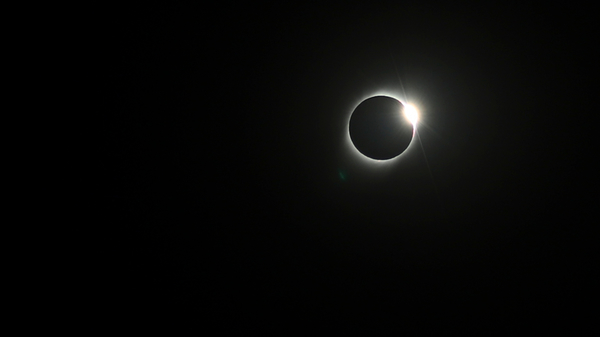
The diamond ring: shortly before the Moon covers the Sun completely, the faint solar corona becomes visible. The small remaining part of the Sun’s disk dazzles like a diamond set in a ring.
©Anne Buckle/timeanddate
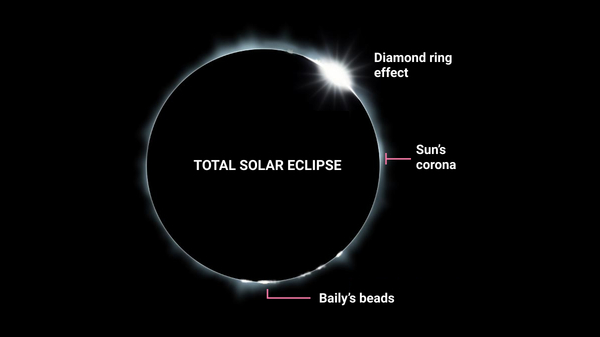
Phenomena only visible near the totality.
©bigstockphoto.com/JohanSwanepoel
Some sights are only visible during a total solar eclipse. They appear in this order as totality sets in (and in reverse order as totality ends):
- Shadow bands: About a minute before totality, moving, wavy lines of alternating light and dark can be seen on the ground and along walls. These shadow bands are the result of Earth’s turbulent atmosphere refracting the last rays of sunlight.
- Diamond ring: Seen about 10 to 15 seconds before and after totality, the solar corona (the outer atmosphere of the Sun) becomes visible. Together with the single jewel of light from the Sun, it creates the well-known diamond ring effect.
- The Sun's corona: As the diamond ring fades, the outermost part of the Sun's atmosphere becomes more prominent. It is visible as a faint ring of rays surrounding the silhouetted Moon and is around 200–300 times hotter than the Sun’s surface—its temperature can reach over 1 million °C (1.8 million °F).
- Baily's beads: About five seconds before totality, Baily's beads appear. They are little bead-like blobs of light at the edge of the Moon created by the sunlight passing through gaps in the mountains and valleys on the Moon's surface.
- The Sun's chromosphere: The second most outer layer of the Sun’s atmosphere gives out a reddish glow. It is only visible for a few seconds right after totality.
These events then repeat in reverse order: First, the Sun's chromosphere reappears just before totality ends. The Baily's beads follow this as the Moon continues to move away. The diamond ring and corona then makes an appearance, following which shadow bands reappear before the crescent Sun is visible again.
The Science of Total Solar Eclipses
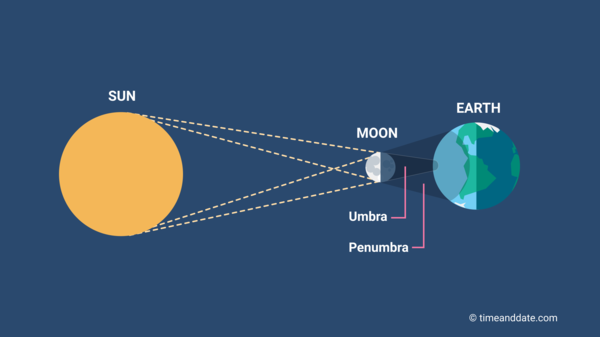

The Sun, Moon, and Earth are aligned
©timeanddate.com
On average, one total solar eclipse happens every 18 months, when:
- There's a New Moon,
- at the same time, the Moon is at (or very near) a lunar node, so the Earth, the Moon, and the Sun line up in a straight (or nearly straight) line,
- and the Moon is near perigee.
Eclipse Shadows: Umbra, Penumbra, and Antumbra
Not Every New Moon
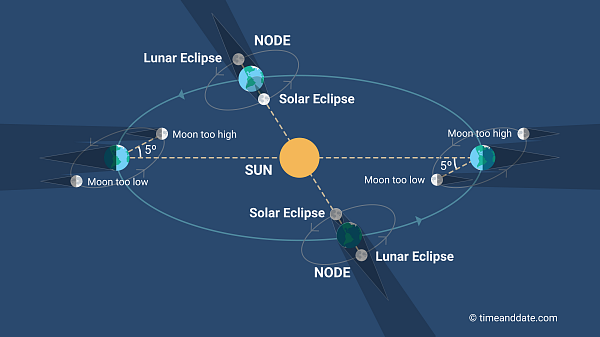

Lunar nodes are the locations where the Moon crosses the Earth's orbital plane.
The Moon's orbital path around Earth is inclined at an angle of approximately 5° to the Earth's orbital plane around the Sun (the ecliptic). Without this slant, we would be able to see two eclipses per lunar month—a solar eclipse at every New Moon and a lunar eclipse at every Full Moon. In reality, solar eclipses happen only 2—5 times a year.
For a solar eclipse to occur, the New Moon must be at or very close to one of the two points where the orbital planes meet. These locations are called lunar nodes.
If the Moon is not near a lunar node during New Moon, the Sun, Moon, and Earth do not align in a straight or almost straight line, and a solar eclipse cannot occur. Seen from Earth, the Moon passes just above or just below the Sun (see image).
Near Lunar Perigee
The Moon's path around Earth is elliptical, with one side of the orbit closer to Earth than the other. The point closest to Earth is called the perigee and the side farthest from Earth is known as the apogee.
Earth's orbit around the Sun is also elliptical, with the Sun closest at perihelion, and farthest away at aphelion.
Earth's and the Moon's elliptical orbits mean that Earth’s distance from the Sun and the Moon's distance from Earth varies throughout the year. It also means that from Earth, the Sun's and Moon's apparent sizes change during the year.
When the Moon is about 400 times closer to Earth than the Sun, the Moon's and the Sun's apparent sizes roughly match. Because of this, total eclipses of the Sun can only occur when the Moon is near perigee—it is the only time when the disk of the Moon looks big enough to cover the entire disk of the Sun.
What if the Moon is near apogee?
How Long Does Totality Last?
A total solar eclipse can last for several hours and totality can range from a few seconds to 7.5 minutes. The longest total solar eclipse of the 21st century took place on July 22, 2009, when totality lasted 6 minutes and 39 seconds!





